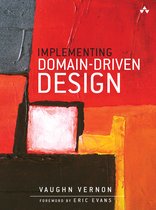Domain-Driven Design S'attaquer à la complexité au cœur du Logiciel
- en
- Couverture rigide
- 9780321125217
- 11 septembre 2003
- 560 pages
Résumé
Spécifications produit
Contenu
- Langue
- en
- Binding
- Couverture rigide
- Date de sortie initiale
- 11 septembre 2003
- Nombre de pages
- 560
- Illustrations
- Non
Personnes impliquées
- Auteur principal
- Eric Evans
- Deuxième auteur
- Ross Venables
- Coauteur
- Eric Evans
- Rédacteur en chef
- John Fuller
- Editeur principal
- AWPC
Autres spécifications
- Hauteur de l'emballage
- 41 mm
- Hauteur du produit
- 38 mm
- Largeur d'emballage
- 185 mm
- Largeur du produit
- 178 mm
- Livre d‘étude
- Oui
- Longueur d'emballage
- 242 mm
- Longueur du produit
- 235 mm
- Poids de l'emballage
- 1048 g
- Police de caractères extra large
- Non
- Édition
- 1
EAN
- EAN
- 9780321125217
Vous trouverez cet article :
- Catégories
- Livre, ebook ou livre audio ?
- Livre
- Langue
- Anglais
- Disponibilité
- Disponible à l'adresse suivante
Avis
Négatif, positif, neutre ; quel qu'il soit, nous publions chaque avis. Nous vérifions d'abord s'il répond aux conditions et s'il est authentique. Nous vérifions également qu'il ait été écrit par quelqu'un qui a acheté l'article via bol.com. Le cas échéant, nous le mentionnons. Les contrôles sont automatiques, même si des collaborateurs y jettent parfois manuellement un oeil. Bol.com n'offre pas de paiement pour ces avis. Si un évaluateur a reçu une compensation d'un tiers, cette information est indiquée dans l'évaluation elle-même.
Négatif, positif, neutre ; quel qu'il soit, nous publions chaque avis. Nous vérifions d'abord s'il répond aux conditions et s'il est authentique. Nous vérifions également qu'il ait été écrit par quelqu'un qui a acheté l'article via bol.com. Le cas échéant, nous le mentionnons. Les contrôles sont automatiques, même si des collaborateurs y jettent parfois manuellement un oeil. Bol.com n'offre pas de paiement pour ces avis. Si un évaluateur a reçu une compensation d'un tiers, cette information est indiquée dans l'évaluation elle-même.
-
Traduit automatiquementAfficher uniquement les 3 premiers points
positif points
- Accessible
- Applicable en pratique
- Explication claire
- Complet
- Complet
Un beau livre sur DDD. Vous remarquez que le contenu de 2003 lors de sa rédaction a toujours des arêtes vives. Cependant, cela reste une base particulièrement bonne pour DDD.
Avez-vous trouvé cet avis utile ?00 -
Traduit automatiquement
positif points
- Pratique
- Complet
négatif points
- ici et là trop technique.
Beaucoup de bons exemples autour de la conception axée sur le domaine.
Avez-vous trouvé cet avis utile ?00 -
Traduit automatiquementAfficher uniquement les 3 premiers points
positif points
- Explication claire
- Applicable en pratique
- L'état de l'art
- Complet
- Complet
négatif points
- beaucoup d'informations en une seule fois
Très bon livre sur le Domain Driven Design. Cela va bien et de manière compréhensible en la matière, mais parfois le matériel doit être soigneusement examiné.
Avez-vous trouvé cet avis utile ?00 -
Traduit automatiquement
positif points
- Complet
négatif points
- Trop théorique
- parfois assez difficile
Si vous avez toujours voulu apprendre DDD, c'est le livre pour commencer
Avez-vous trouvé cet avis utile ?00
Choisissez la version souhaitée
Informations sur les prix et commande
Le prix de ce produit est de 40 euros.- Livraison comprise avec bol
- Retrait possible dans un point-relais bol
- 30 jours de réflexion et retour gratuit
- Service client 24h/24
- Livraison en soirée même en semaine
- Jour de livraison au choix
Souvent achetés ensemble
Signaler cet article
Vous souhaitez signaler un contenu illégal à propos cet article:
- Je souhaite faire un signalement en tant que client.
- Je veux faire un signalement en tant qu'autorité ou personne de confiance.
- Je veux faire un signalement en tant que propriétaire de partenaire
- Je veux faire un signalement en tant que propriétaire de marque
Vous n'êtes pas un client, une autorité, personne de confiance, propriétaire de marque ou un partenaire ? Dans ce cas, utilisez le bouton ci-dessous pour effectuer un signalement.









